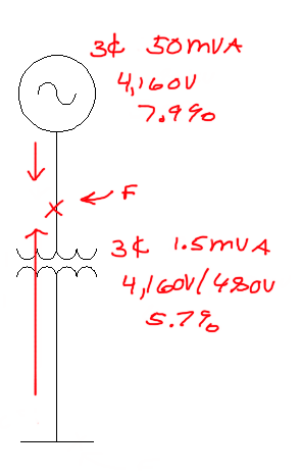supra33202
Well-known member
- Joined
- Jan 6, 2012
- Messages
- 52
- Reaction score
- 1
This is from Fault Current Analysis quiz at http://www.electricalpereview.com. @Zach Stone, P.E.

The fault is between the generator and the transformer. Does the transformer to the fault current? If yes, why?
My solution:
Since the fault happens at the upstream of the transformer, only the generator contributes to the fault current. In this case, power (or current) flows from upstream to downstream. Generator generates power. Transformer doesn't generate power. Transformer transforms voltages. The power at primary side of the transformer is equal to the power at the secondary side of the transformer. There is only one KVA rating (power) in a transformer. Voltage and current at the power transformer (autotransformer is different) might/will change, but the power input and power output will not change.
MVA method:
Sg= 50MVA/7.9%= 632.9 MVA
Isc=6329.9MVA/(sqrt(3)*4160V) = 87.9KA
Please advise.
Thanks!

The fault is between the generator and the transformer. Does the transformer to the fault current? If yes, why?
My solution:
Since the fault happens at the upstream of the transformer, only the generator contributes to the fault current. In this case, power (or current) flows from upstream to downstream. Generator generates power. Transformer doesn't generate power. Transformer transforms voltages. The power at primary side of the transformer is equal to the power at the secondary side of the transformer. There is only one KVA rating (power) in a transformer. Voltage and current at the power transformer (autotransformer is different) might/will change, but the power input and power output will not change.
MVA method:
Sg= 50MVA/7.9%= 632.9 MVA
Isc=6329.9MVA/(sqrt(3)*4160V) = 87.9KA
Please advise.
Thanks!
Last edited by a moderator:






















